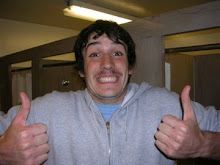We took a two day trip to Dublin over the weekend. It's a big city with more of an international feel than the smaller Irish charm of Galway, but the history of the city is immense and it was a an awesome way to get a better perspective of Irish culture.

Our hostel was The MarlBoRough Hostel. Very friendly. It felt almost like a commune. You share a kitchen, Internet, TV room, courtyard and bathrooms and showers. Lots of younger international people. We actually met some people from Germany and Belgium that we ended up going out to the bars with.

This spire is a feature of the city. I don't think the locals like it much. It seems to stick out, though it is impressively big.

 One of our major goals of the trip was to visit the Guinness storehouse. Though they brew Guinness elsewhere now, there is still a museum tour you can take in Dublin. It was a bit artificial but well worth it.
One of our major goals of the trip was to visit the Guinness storehouse. Though they brew Guinness elsewhere now, there is still a museum tour you can take in Dublin. It was a bit artificial but well worth it.
250 years of Guinness


The man himself, Arthur Guinness

Tasting room

One of my favorite parts was the advertising of the past. Apparently in the 1950's Guinness was good for you. I took way too many pictures.






The creator of the famous "my goodness my Guinness" posters John Gilroy.

I got to pour my own pint.

The tour finishes with a bar at the top, and since it was such a nice day you could see all of Dublin.
Next day we trekked to Croke Park, home of the Gaelic Athletic Association (GAA) where they play such games as Hurling and Gaelic Football. The stadium holds some 83,000 people and is the 4th largest stadium in Europe. Though Hurling and Gaelic Football aren't even professional sports, there is still a huge draw for them. Surprisingly, this was one of the best things we did during the trip. The revival of the Irish games occurred at the same time as much of the militant attempts to gain Irish independence from Britain. Many Irish nationalist were afraid that their culture was dying out so they began to try and revive Irish language, dance, music and Gaelic games. I don't think the GAA was meant to be political but there had to be some connection.

 The stand to the left is known as Hill 16. It is the place where Dublin fans like to be when their team plays. Apparently, its called Hill 16 because it was originally built on old ruble from the Easter Rising of 1916. The Easter Rising was a militant attempt by Irish republicans to gain independence from Britain. Another of the stand was called Hogan stand after one of the coaches (Michael Hogan) along with 13 others were killed when a British officer opened fire in Croke Park on the day known as Bloody Sunday. More than just a stadium, Croke park is steeped in history, which is why I think I liked it so much.
The stand to the left is known as Hill 16. It is the place where Dublin fans like to be when their team plays. Apparently, its called Hill 16 because it was originally built on old ruble from the Easter Rising of 1916. The Easter Rising was a militant attempt by Irish republicans to gain independence from Britain. Another of the stand was called Hogan stand after one of the coaches (Michael Hogan) along with 13 others were killed when a British officer opened fire in Croke Park on the day known as Bloody Sunday. More than just a stadium, Croke park is steeped in history, which is why I think I liked it so much.
 This statue in Dublin Castle was built by the British and apparently faces away from the rest of the city. A symbol that the British didn't respect the Irish. Also, until they drilled holes in it, the balance would be unequal when it rained.
This statue in Dublin Castle was built by the British and apparently faces away from the rest of the city. A symbol that the British didn't respect the Irish. Also, until they drilled holes in it, the balance would be unequal when it rained.
 We finished our trip with a visit to the old Jameson Distillery. Like Guinsess, Jameson isn't distilled in Dublin anymore but they still offer a tour. It was really cheesy and artificial, but there was a happy ending.
We finished our trip with a visit to the old Jameson Distillery. Like Guinsess, Jameson isn't distilled in Dublin anymore but they still offer a tour. It was really cheesy and artificial, but there was a happy ending.




















